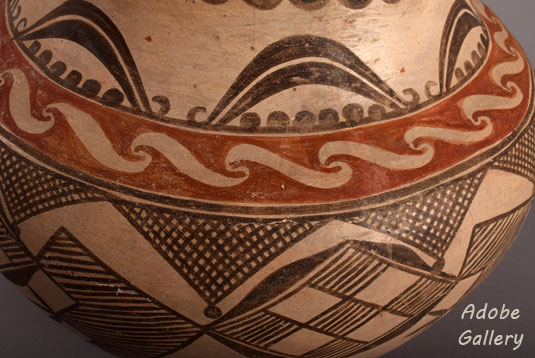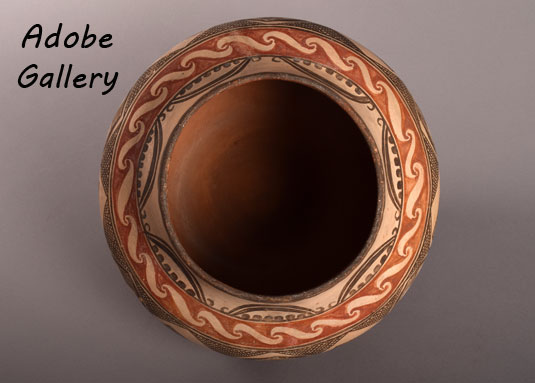Historic Zia Pueblo Nineteenth Century Pottery Jar with Band and Hachure Designs [SOLD]
+ Add to my watchlist Forward to Friend
- Category: Historic
- Origin: Zia Pueblo, Tsi-ya
- Medium: clay pigment
- Size: 10-½” tall x 12-¼” diameter
- Item # C4427A SOLD

The use of a neckband design, such as on this pottery jar, began around 1820 as a standard item. Concurrently, there began a freer expression of designs by potters at Zia Pueblo. Then, around 1890, we began to see the design settle on a three-band approach—body, shoulder, and neck.
Resting on the flat section of the shoulder is a series of interlocked spirals in the cream slip, framed in the band of red slip, with no black line outlining. The prime body area is basically filled with fine line and crisscross hachure designs, some in triangles, some in diamonds, and some in stepped elements.
The neck design consists of split crescents arched over small black dots. Above the crescents, just below the rim is a band of semicircles, generally thought to be clouds.
The use of red slip in the design was limited to the shoulder and the triangles resting on the lower framing line. Below the double framing lines is a wide red band, wiped on top of the polished underbody clay.
“An invariable feature of Zia pottery vessels from about 1650 to about 1930 is a red band that separates the cream-colored slipped surface from the unslipped underbody of a vessel; after 1930, a separate red band is no longer used. . . Changes occurred over time in the contrast between the color of the red band and that of the unslipped underbody, and these changes can be helpful in dating a particular vessel. On San Pablo Polychrome and Zia Polychrome vessels, the contrast between the slip band and the paste is usually apparent, and the polishing of the unslipped underbody is typically rather rough. On Zia Polychrome vessels, the contrast tends to decrease, and by around 1900-1910 it is often difficult to detect the difference between the red band and the underbody paste, which is more smoothly polished on earlier vessels.” Harlow and Lanmon, 2003:23
The combination of vessel shape, shoulder design, body design, and the width and intensity of the red band on the underbody, steers us to date this jar to between 1890-1900.
Condition: very good condition
Provenance: this Historic Zia Pueblo Nineteenth Century Pottery Jar with Band and Hachure Designs is in from a gentleman in Albuquerque
Recommended Reading: The Pottery of Zia Pueblo by Harlow and Lanmon
Relative Links: Southwest Indian Pottery, Zia Pueblo, Historic Pottery

- Category: Historic
- Origin: Zia Pueblo, Tsi-ya
- Medium: clay pigment
- Size: 10-½” tall x 12-¼” diameter
- Item # C4427A SOLD



